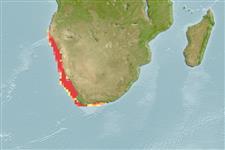Teleostei (teleosts) >
Pleuronectiformes (Flatfishes) >
Soleidae (Soles)
Etymology: Austroglossus: Composed from Austro = the south + Greek, glossa = tongue (Ref. 45335).
More on author: Bleeker.
Environment: milieu / climate zone / depth range / distribution range
Ecology
Marine; bathydemersal; depth range 100 - 400 m (Ref. 5304). Deep-water; 17°S - 35°S, 10°E - 25°E
Southeast Atlantic: northern Namibia to False Bay, South Africa.
Size / Weight / Age
Maturity: Lm ? range ? - ? cm
Max length : 75.0 cm TL male/unsexed; (Ref. 3200); max. published weight: 4.0 kg (Ref. 3200)
Short description
Identification keys | Morphology | Morphometrics
Dorsal spines (total): 0; Dorsal soft rays (total): 82 - 100; Anal spines: 0; Anal soft rays: 65 - 78; Vertebrae: 55 - 57. Dorsal and anal fins continuous with caudal fin (Ref. 36731). Right pectoral fin more than half of, but shorter than head length; left pectoral fin present (Ref. 36731). Brownish with small dark specks; sometimes with bars on body (Ref. 3200).
Larvae are pelagic (Ref. 27121, Ref. 36731), while adults live close to the sea bed (Ref. 36731). Adults feed on worms, crustaceans, mollusks, and fish (Ref. 27121, Ref. 36731). Utilized as a food fish (Ref. 4931).
Life cycle and mating behavior
Maturities | Reproduction | Spawnings | Egg(s) | Fecundities | Larvae
Heemstra, P.C. and O. Gon, 1986. Soleidae. p. 868-874. In M.M. Smith and P.C. Heemstra (eds.) Smiths' sea fishes. Springer-Verlag, Berlin. (Ref. 3200)
IUCN Red List Status (Ref. 130435)
Threat to humans
Harmless
Human uses
Fisheries: minor commercial
Tools
Special reports
Download XML
Internet sources
Estimates based on models
Preferred temperature (Ref.
123201): 9.2 - 11.9, mean 10.4 °C (based on 37 cells).
Phylogenetic diversity index (Ref.
82804): PD
50 = 0.7500 [Uniqueness, from 0.5 = low to 2.0 = high].
Bayesian length-weight: a=0.00977 (0.00473 - 0.02021), b=3.07 (2.90 - 3.24), in cm total length, based on LWR estimates for this (Sub)family-body shape (Ref.
93245).
Trophic level (Ref.
69278): 3.5 ±0.45 se; based on food items.
Resilience (Ref.
120179): Low, minimum population doubling time 4.5 - 14 years (K=0.07).
Fishing Vulnerability (Ref.
59153): Moderate to high vulnerability (50 of 100).
Climate Vulnerability (Ref.
125649): Very high vulnerability (89 of 100).
Nutrients (Ref.
124155): Calcium = 22.9 [8.9, 62.1] mg/100g; Iron = 0.34 [0.14, 0.79] mg/100g; Protein = 17.3 [15.4, 19.3] %; Omega3 = 0.16 [0.07, 0.32] g/100g; Selenium = 18.9 [7.7, 48.0] μg/100g; VitaminA = 5.86 [1.10, 30.86] μg/100g; Zinc = 0.326 [0.204, 0.498] mg/100g (wet weight);
